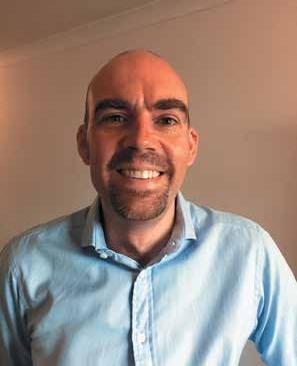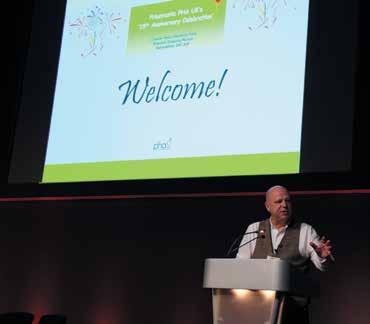
5 minute read
Stem cell research
from Emphasis Winter 2015
by PHA UK
CELLSEARCHING
Dr Dan Reed, a research associate at the National Heart and Lung Institute, Imperial College London, was recently commissioned by PHA UK to publish a guide to stem cell research, aimed at patients. Sally Brown spoke to Dan about his interest in stem cell research and how to communicate the implications to patients.
As an Imperial College scientist and an Honorary Research Fellow at the Royal Brompton Hospital, Dr Dan Reed currently works on a range of projects that study stem cells and their possible benefits in the study and treatment of pulmonary hypertension (PH).
His latest book for PHA, called ‘Stem cells and scientific research in pulmonary hypertension’, attempts to explain stem cell therapy in layman’s terms and looks at how ongoing research into the use of adult stem cells could help conditions like PH by stimulating repair to blood vessels in the lungs.
The book also highlights how stem cells can be used, not just as therapies, but as tools to help scientists learn more about the disease in the laboratory and develop new treatments this way.
These days it is possible to take blood samples from anyone, and grow stem cells from their blood which can then be used to produce new blood vessels or a piece of muscle. This enables scientists and doctors to learn about diseases in the lab without invasive procedures.
Dan is particularly interested in ‘personalised medicine’ where medical decisions, practices, and products are tailored to the needs of the individual patient. His guide explains the biology of stem cells, stem cell therapy and how stem cells are used in laboratory research into PH.
Scientists and doctors fully understand that having a lifethreatening disease like PH makes people feel desperate, and sufferers often look abroad for cures and treatments. However leading doctors, and charities such as the PHA, recommend that patients don’t go down the stem therapy route at this time.
“Stem cell therapy is an exciting treatment because of the potential to repair damaged tissue, but our knowledge of how stem cells work on the lung or the heart isn’t advanced
enough for this treatment to be ready,” said Dan.
“It is a very different stem cell system to the one we use in bone marrow transplants in cancer treatment for example.”
“Because of the extensive media attention around stem cell research, several institutions have started offering stem cell therapy for a range of diseases, including PH.
“But there are still a lot of questions to be answered and many scientists are rightly wary of making false claims.”
Some companies charge thousands of pounds for so-called stem cell therapies which don’t necessarily work. There are many different types of stem cells which all do different jobs and until scientists and doctors know what they all do, there are a lot of unanswered questions.
Dan is currently working with Professor Jane Mitchell using stem cells from patients’ blood to make discoveries about PH. The main challenge is the funding to support the research, as well as the scientific expertise. Funding is very competitive and scientists often don’t know in advance whether their work will make a small difference or whether it will be a quantum leap forward.
Keen to demystify the subject, Dan attends numerous discussion forums to help patients understand the current research. One of his presentations was at the PHA annual conference in April 2014, and again in October 2015, where he presented the findings of the field’s latest research and took questions from the audience.
“This was my first real opportunity to speak with patients about research in PH, and this isn’t something scientists normally have the chance to do” said Dan.
“In meeting patients and their families the importance of good communication between scientists and the patient community became clear to me, and this was something I wanted to get involved in”
Dan’s work with the PHA and their patients has really changed his perspective on the importance of the research that he’s involved in and how that research is communicated to patients.
“It can really impact on patients’ quality of life and their healthcare. We need to guide them through stem cell and other PH research and be there to give the right support and advice.
“It’s a minefield for people to navigate and it can add to their anxiety or confusion. Scientists need to be at the heart of this to explain and reassure.”
Dan firmly believes that people’s quality of life can be influenced not just by what happens in the lab but by what is said in the media, and by scientists, about their condition.
“Having worked with the PHA for the past few years I really hope that this will be the start of more opportunities for scientists to interact with patients. This is, of course, good for patients, but also encourages us, as scientists, to really think about our research from the patient perspective, and how we communicate what we find.” Free copies of Dan’s book, and accompanying DVD, are available from the PHA, telephone: 01709 761450 or email: office@phassociation.uk.com . SOME FACTS ABOUT STEM CELLS
• Stem cells are a special type of cell – they can change themselves into other types of cells in the body, such as heart cells or lung cells. • There are broadly two types of stem cell – embryonic stem cells and adult stem cells (sometimes called progenitor cells). • Some types of adult stem cells, taken from bone marrow, are currently being used to treat cancer and some types of immune disease. • In the future it might be possible to replace damaged lung blood vessels with cells made from stem cells – however, there is still a lot of research to be carried out. • Scientists are, however, already able to use blood vessels made from adult stem cells in the laboratory, and use them to make new discoveries about
PH, develop new drugs, or determine the best drugs for individual patients based on their cells.
Photo courtesy of National Heart and Lung Institute, Imperial College London











